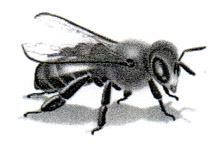(Courtesy of Joli Winer, The Bee Buzzer of the Northeastern Kansas Beekeepers Association, August 2015)
- Use the weed eater and mow around your hives so that the bees can get in and out.

- After pulling off your supers check your hives to make sure they have laying queens.
- Provide water for your bees—this will keep your bees alive in this heat.
- Bees are hanging on the outside of the hives to help keep it cooler inside the hives—not much honey coming in so they are just keeping cool.
- Harvest any fall honey & get it extracted. Any honey that you pull off to extract should be extracted within a few days; in this heat wax moth damage can happen in just a few days. Also, small hive beetle can also do a great deal of damage to your supers and your honey. Don’t pull your honey off until you are ready to extract.
- Check moisture on your honey.
- Complete a fall inspection for each hive
- Take an inventory at your bee yards to see what equipment you need to repair or replace over the winter.
- Get your entrance reducers on towards the end of September to keep mice out of your hives. Check for mice before installing mouse guards. Check your bottom boards for holes big enough for a mouse to go through.
- Store any frames with drawn comb with paradichlorobenze (moth crystals). Wax moth damage can be devastating to your combs. Store them in a cool ventilated area. Do not store your supers in plastic garbage bags as this acts as an incubator for the wax moth!
- Update your record book—you won’t remember in the spring!
- Check your hives for stored honey. Most colonies will need 40-60 pounds of honey to winter successfully. The top deep super/hive body should be packed full of honey. If it isn’t, you should feed the bees some syrup. If mixing your own syrup in the fall, the mixture should be 2:1 sugar to water by weight. That would be 4 lbs. of sugar to 2 lbs. of boiling water. You can also get high fructose corn syrup. However, you may not use corn syrup or any type of syrup that you purchase at the grocery store. It has things in it that can cause problems with your bees. NEVER feed honey purchased from the grocery store—it can spread diseases to your bees.
Here are the reasons bees die over the winter; make sure you take care of these problems in the fall:
- Bees run out of honey
- Too few bees to maintain the cluster
- The bees’ digestive tracts compact with too much wasted matter
- They exhibit parasitic mite syndrome
- Check your colonies to see if you need to treat for Varroa mites.
- Combine a weak colony with a stronger colony.
- Keep a vigilant eye out for small hive beetles. Inspect your hives to make sure you have a good laying queen. You should see brood in all stages (eggs, larvae, capped).
- If treating for mites, get your treatments on as soon as possible. Mark your calendar with the date they went in and the date they should come out. The earlier you can get your treatments on for Varroa mites, the better chance you have of getting healthy young bees into the hive to make it through the winter.
- Make sure your brood is in the center of the bottom hive body. Arrange honey frames on the sides and in the top hive body—it should be full of honey. If it isn’t, feed your bees syrup.
- Make sure your hives are tipped forward, just slightly, so water doesn’t pool on the bottom board and cause moisture problems.